By Tisa Mason
Hays, KS – Once you become a parent, you never really quit being a parent. Any parent of a child with intellectual or developmental disabilities knows that their responsibilities will be extensive long after their son or daughter reaches adulthood. Supporting a child with special needs is often a life-long commitment comprising equal parts unconditional love and unwavering advocacy.
FHSU professor of art and design Amy Schmierbach’s teenage son Lucas has Autism. Amy has spent the better part of the past decade working to make Hays a more inclusive community for children and adults like Lucas.
Amy’s efforts began in 2015 as a collaborative art project involving her art students and clients of Disability Services of Northwest Kansas (DSNWK). The artistic medium she chose was weaving. She chose weaving because it didn’t require expensive materials, created little mess, offered great opportunities for dialog and collaboration, and because it involved techniques that didn’t demand a wealth of manual dexterity.
The program grew, even during the pandemic, as Amy moved the sessions online to the Zoom platform. The new format allowed Amy to begin including DSNWK clients from outside the local area. The expanded sessions now also include participants from Victoria, Russell, and as far away as Hoxie.
In 2016, there was a tragic officer-involved shooting death in Hays involving an intellectually disabled young adult. What started as a routine traffic stop quickly escalated into a police pursuit that ended in a physical confrontation. A later investigation confirmed that the officer involved, fearing for his life, acted appropriately in the situation. It was the worst nightmare imaginable for any parent of an intellectually or developmentally disabled child or adult.
Amy believed it was a tragedy that might have been avoided if the police officers involved had understood more about how intellectually and developmentally disabled individuals process and respond to extreme stress. Finding a proactive and purposeful response to address this issue has become a very personal quest.
Fast-forward to 2017, and in a Hays community that was beginning to recover from the tragic events of 2016. Amy thought this might be an appropriate time to share her thoughts on how our community might come together to ensure this kind of tragedy would never happen again. She also knew she would have to be very thoughtful and patient in her approach if her efforts were to yield the positive change she envisioned.
Amy first approached Scott Stults and Sara Biggs, both directors of programs & services at DSNWK, with her idea of expanding her community art project to include first responders. “My goal was to use the collaborative art approach to create friendships, understanding, and empathy among the first responders who, through the nature of their work, are very likely to encounter the disabled at a time of maximum stress,” said Amy.
Scott and Sara suggested Amy take an incremental approach. She began her outreach via a series of emails to local law enforcement, fire, and emergency medical services leaders. The first to respond within a day was Hays Fire Chief Ryan Hagans. Chief Hagans said the Hays Fire Department was all-in.
Ellis County Health Services Director Jason Kennedy responded soon after, expressing great interest as well. Ellis County Sheriff Scott Braun and Hays Police Chief Don Shiebler also joined the initiative rounding out the level of participation Amy, Scott, and Sara once thought would be a reach.
In the spring of 2022, Amy and her Community Engaged Art Class (Art 308) hosted the first of what was to become Amy’s First Responder, Art, Collaboration, Training (FACT) events in the Schmidt Foundation for Art and Design building at FHSU. Each session begins with a one-hour workshop for first responders and FHSU students, where both groups learn about some essential characteristics of the DSNWK clients they will soon meet at the weaving loom.
The workshops provide background information on behaviors first responders are likely to encounter in real-world scenarios involving intellectually and developmentally delayed children and adults. The information she shares includes guidance specific to fire and rescue, EMS, and law enforcement professionals.
After the workshop, it’s time to make personal connections and weave. Each local department typically sends two participants to the event, and three to four weaving teams of first responders, FHSU students, and DSNWK clients man each station loom. Often the experienced weavers-the DSNWK clients- serve as instructors for the novice first responders and students.
Students and first responders often move among the looms and quickly learn that while many clients share common characteristics, they are all every bit as unique as every other human.
“The differences in our clients is significant,” Scott said. “FACT events deliver a powerful educational experience that works both ways.”
“Our clients really look forward to these events,” Scott continued. “They love the socialization and doing things outside their normal routine.”
Many of Scott and Sara’s clients may struggle to express themselves verbally, but the first responders and students quickly learn that they hear and understand what is said to them pretty well. This eye-opening realization alone will undoubtedly come in handy for these first responders the next time they encounter an intellectually or developmentally disabled person in a high-stress situation.
This column was designed to focus stories about the faculty, staff, students, and alumni of FHSU who are personally committed to providing an accessible quality education to Kansas, the nation, and the world through an innovative community of teacher-scholars and professionals to develop engaged global citizen-leaders. There is no better example of an FHSU Tiger living a life of purpose in pursuit of our mission than Amy Schmierbach.













